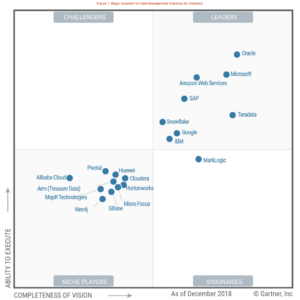
What Gartner Sees In Analytic Hubs

(Logolord/Shutterstock)
In the old days, companies would build their business intelligence strategies from the ground up, typically starting with a traditional data warehouse. But as the volume, trajectory, and types of data have exploded, companies have looked for more agile solutions to drive their analytics strategies. The state of the art in this software genre is something that Gartner calls a data management solution for analytics (DMSA), or an “analytics hub.”
According to Gartner, a DMSA is a “complete software system that supports and manages data in one or many file management systems, most commonly a database or multiple databases.” Depending on the underlying data model used – such as relational, XML, JSON, key-value, geospatial, or graph — a DMSA can take on many different flavors, including traditional SQL analytics, machine learning, or graph processing.
Gartner identifies four primary use cases for DMSAs, including:
- Traditional data warehouse: These are your standard column-oriented relational databases optimized for processing queries on high volumes of structured data that’s typically loaded through batch jobs
- Real-time data warehouse: These are typically next-gen databases designed to run in-memory (or atop solid-state storage) to support fast, low-latency decision-making on data that’s continually updated
- Context-independent warehouse: These are specialized databases that are designed for more free-form exploration and mining of less structured data without strict time constraints, using advanced analytics, search, and graph techniques, often for the purpose of generating forecasts and predictions
- Logical data warehouse: This database serves as a logical access point for accessing a variety of structured and unstructured data sources for multiple users and use cases, from standard SQL queries to machine learning.
DMSA Leaders
Nineteen vendors made the cut for Gartner’s “Magic Quadrant for Data Management Solutions for Analytics,” which was published last week.
That included eight in the Leader’s Quadrant, one in the Visionaries Quadrant, and 10 in the crowded Niche Players Quadrant. No vendors landed in the Challengers Quadrant, which led Gartner analysts Adam Ronthal, Roxane Edjlali, and Rick Greenwald to conclude there are essentially two cohorts to the DMSA group.
The best vendors can address all four DMSA use cases and are continually adapting their solutions to meet the changing demands. That means all the leaders have cloud strategies, and they all have a vision to “address the broader DMSA market beyond traditional data warehousing,” the authors write.
The age of disruption of cloud and non-relational technologies is over, Gartner says, as DMSA vendors based on these approaches become the established norm. This means that large vendors are “rediscovering” their strengths, Gartner says, while it pushes niche products further away from the mainstream.
Oracle is firmly in charge of the DMSA field with its Autonomous Data Warehouse offering. The closest vendors to Oracle are AWS and Microsoft Azure, which offer cloud-first solutions buyoyed by the vendors’ “strong vision” and financial backing. SAP also rates highly with its DMSA, but its general purpose (i.e. not tied to SAP’s offerings) means it’s not yet ready to challenge the top leaders.
Snowflake Computing and Google both are newcomers to the Magic Quadrant. Gartner likes Snowflake’s growth and momentum, while it heralded Google’s efforts to boost enterprise sales.
Gartner says perennial leaders Teradata and IBM, “have struggled to maintain their market positions in recent years.” IBM’s switch from Netezza to Db2 technology has met with mixed reaction from the customer base, and its core products are “less flexible and agile” than emerging competitors, Gartner says. Teradata, meanwhile, continues to lead in technical product capabilities, but it’s suffering in market perception as it transitions to the cloud.
The only vendor to make the cut in the Visionary category was Marklogic, which develops a multi-modal NoSQL database. Gartner heralded its cloud offerings and pricing model, but wondered whether customers would understand its value as an analytics hub.
DMSA Challengers
Gartner grouped the Hadoop DMSA vendors – Cloudera, MapR and Hortonworks (which has since merged with Cloudera) – into its own cohort within the Challenger’s Quadrant. These vendors have strengths in supporting data lakes and context-independent use cases, Gartner says, but struggle to meet requirements for traditional data warehouses and have yet to complete the transition to the cloud.
A second cohort of Challengers consists of emerging Chinese firms, including Alibaba Cloud, GBase, and Huawei. While Gartner considers their products “generally capable,” they remain mostly used in the Asia Pacific region, and face headwinds for use in North America and Europe, the analyst firm says.
Neo4j is another challenger with a strong story to tell in one area: Graph processing. Gartner says Neo4j is the dominant vendor in graph, and likes how easy it is for customers to get started. But limited applicability outside of graph lowered its DMSA marks.
Treasure Data, which was acquired by ARM, also got good marks for its Customer Data Platform, which got good marks for customer satisfaction and cross-industry reach. But it was dinged for by customers for product complexity and value.
Pivotal got decent marks with its Greenplum database, which customers noted was performant, scalable, and open. But the lack of maturity of cloud offerings and complexity hurt its final score.
Micro Focus is the new home for the Vertica MPP offering, which Gartner praised for its analytics and data science capabilites. But a decline in market share and mind share, as well as a slow move to the cloud, put a damper on its rating.





























